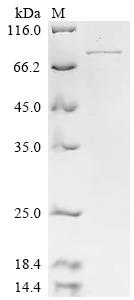To produce recombinant human neurofilament light polypeptide (NEFL) in E. coli, the gene encoding the full length of mature human NEFL protein (2-543aa) is co-cloned into an expression vector with a C-terminal 6xHis-tag gene and transformed into E. coli cells. The bacteria are cultured under conditions that induce protein expression. Once adequate growth is achieved, the cells are lysed to release the recombinant NEFL protein. Purification is done using affinity chromatography. The purity of the recombinant NEFL protein is confirmed using SDS-PAGE, reaching over 90%.
The Human NEFL is a vital component of neurofilaments, which are structural proteins forming the neuronal cytoskeleton. NEFL is a light polypeptide that, along with medium and heavy polypeptides, constitutes the three subunits of neurofilaments [1]. These neurofilaments are crucial for maintaining the structural integrity of neurons, regulating axonal diameter, and facilitating the normal transmission of nerve signals [2]. NEFL is abundantly present in neurons and axons, playing a significant role in neuronal function [3].
Furthermore, NEFL has been associated with various diseases. Mutations in the NEFL gene have been linked to the development of the Charcot-Marie-Tooth disease [4]. Studies have demonstrated that NEFL mutations can lead to neuropathies affecting the peripheral nervous system [5]. Additionally, NEFL has been implicated in cancer, with research indicating its involvement in promoting an aggressive phenotype in breast cancer and contributing to chemoresistance in head and neck cancer [6][7].
Moreover, NEFL has been investigated in the context of other conditions like Wilms' tumor susceptibility and spinal cord injury, highlighting its diverse roles in different pathologies [8][9]. NEFL has also been shown to impact cell growth, invasion, and apoptosis in head and neck squamous cell carcinoma [10]. Additionally, NEFL regulates neuron apoptosis and nervous system development [11].
References:
[1] H. Kim, S. Kim, H. Kim, H. Kwon, J. Park, A. Leeet al., Phenotypic heterogeneity in patients with nefl‐related charcot–marie–tooth disease, Molecular Genetics & Genomic Medicine, vol. 10, no. 2, 2022. https://doi.org/10.1002/mgg3.1870
[2] J. Zhao, K. Brown, & R. Liem, Abnormal neurofilament inclusions and segregations in dorsal root ganglia of a charcot-marie-tooth type 2e mouse model, Plos One, vol. 12, no. 6, p. e0180038, 2017. https://doi.org/10.1371/journal.pone.0180038
[3] A. Jordanova, P. Jonghe, C. Boerkoel, H. Takashima, E. Vriendt, C. Ceutericket al., Mutations in the neurofilament light chain gene (nefl) cause early onset severe charcot-marie-tooth disease, Brain, vol. 126, no. 3, p. 590-597, 2003. https://doi.org/10.1093/brain/awg059
[4] A. Abe, C. Numakura, K. Saito, H. Koide, N. Oka, A. Honmaet al., Neurofilament light chain polypeptide gene mutations in charcot–marie–tooth disease: nonsense mutation probably causes a recessive phenotype, Journal of Human Genetics, vol. 54, no. 2, p. 94-97, 2009. https://doi.org/10.1038/jhg.2008.13
[5] P. Agrawal, M. Joshi, N. Marinakis, K. Schmitz-Abe, P. Ciarlini, J. Sargentet al., Expanding the phenotype associated with theneflmutation, Jama Neurology, vol. 71, no. 11, p. 1413, 2014. https://doi.org/10.1001/jamaneurol.2014.1432
[6] M. Calmon, J. Jeschke, W. Zhang, M. Dhir, C. Siebenkäs, A. Herreraet al., Epigenetic silencing of neurofilament genes promotes an aggressive phenotype in breast cancer, Epigenetics, vol. 10, no. 7, p. 622-632, 2015. https://doi.org/10.1080/15592294.2015.1050173
[7] B. Chen, J. Chen, M. House, K. Cullen, K. Nephew, & Z. Guo, Role of neurofilament light polypeptide in head and neck cancer chemoresistance, Molecular Cancer Research, vol. 10, no. 3, p. 305-315, 2012. https://doi.org/10.1158/1541-7786.mcr-11-0300
[8] W. Jia, J. Zhu, W. Fu, S. Zhu, F. Deng, H. Xiaet al., Association ofneflgene polymorphisms with wilms’ tumor susceptibility in chinese children, Journal of Oncology, vol. 2019, p. 1-7, 2019. https://doi.org/10.1155/2019/3518149
[9] H. Zhang, D. Wang, J. Tong, J. Fang, & Z. Lin, Mir‐30b‐5p attenuates the inflammatory response and facilitates the functional recovery of spinal cord injury by targeting the nefl/mtor pathway, Brain and Behavior, vol. 12, no. 12, 2022. https://doi.org/10.1002/brb3.2788
[10] Z. Huang, Y. Zhuo, Z. Shen, Y. Wang, L. Wang, H. Liet al., The role of nefl in cell growth and invasion in head and neck squamous cell carcinoma cell lines, Journal of Oral Pathology and Medicine, vol. 43, no. 3, p. 191-198, 2013. https://doi.org/10.1111/jop.12109
[11] S. Wang, D. Ji, Q. Yang, M. Li, Z. Ma, S. Zhanget al., Neflb impairs early nervous system development via regulation of neuron apoptosis in zebrafish, Journal of Cellular Physiology, vol. 234, no. 7, p. 11208-11218, 2018. https://doi.org/10.1002/jcp.27771






